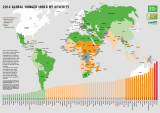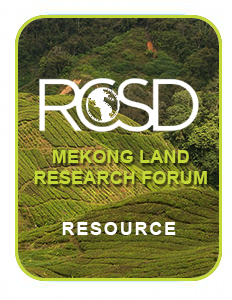Effects of land tenure on agricultural productivity and the environment
Strategies for sustainable agricultural development in the East African highlands
Low agricultural productivity, land degradation and poverty are severe interrelated problems in the East African highlands. While the proximate causes of such problems are relatively well known, the underlying causes are many and complex, and depend upon many site-specific factors that vary greatly across the diverse circumstances of the region. In this paper, we argue that the appropriate strategy for sustainable development depends greatly upon the “pathways of development” that are feasible in a given location.
Synopse Welthunger-Index 2014: Herausforderung verborgener Hunger
Der Welthunger-Index (WHI) 2014 stellt die nationale, regionale und weltweite Hungersituation zum neunten Mal in jahrlicher Folge multidimensional dar. Er zeigt, dass bei der globalen Hungerbekampfung seit 1990 Fortschritte erzielt werden konnten, jedoch angesichts sehr ernster oder gar gravierender Hungerwerte in 16 Landern noch immer groser Handlungsbedarf besteht. Der Schwerpunkt dieses Berichts liegt auf einem entscheidenden Aspekt des Hungers, der haufig ubersehen wird, dem verborgenen Hunger.
Acción colectiva y derechos de propiedad para el desarrollo sostenible
Las instituciones de acción colectiva y los sistemas de derechos de propiedad moldean la forma en que la gente usa los recursos naturales.A su vez, estos patrones de uso afectan los resultados de los sistemas de producción agrícola de la gente. Juntos, los mecanismos de acción colectiva y los sistemas de derechos de propiedad definen los incentivos a los que la gente accede por llevar a cabo estrategias de gestión sostenible y productiva, y afectan el nivel y distribución de los beneficios de los recursos naturales.
2014 Global hunger index by severity
The Global Hunger Index (GHI) is based on three equally weighted indicators: > Undernourishment: the proportion of undernourished people as a percentage of the population (reflecting the share of the population with insufficient caloric intake); > Child underweight: the proportion of children younger than age five who are underweight (that is, have low weight for their age, reflecting wasting, stunted growth, or both), which is one indicator of child undernutrition; and > Child mortality: the mortality rate of children younger than age five (partially reflecting the fatal synergy o
Synthèse l’Indice de la faim dans le monde 2014: Le défi de la faim invisible
Le rapport de l’Indice de la faim dans le monde 2014 – neuvieme edition – propose une mesure multidimensionnelle de la faim au niveau national, regional et mondial. Le GHI 2014 montre les progres effectues en matiere de reduction de la faim depuis 1990, mais des efforts restent a faire, le niveau de la faim restant alarmant voire extremement alarmant dans 16 pays. Cette annee, le GHI se concentre sur un aspect particulier de la faim souvent neglige : la faim invisible.
2014-2015 Global food policy report
This 2014–2015 Global Food Policy Report is the fourth in an annual series that provides a comprehensive overview of major food policy developments and events. In this report, distinguished researchers, policymakers, and practitioners review what happened in food policy in 2014 at the global, regional, and national levels, and—supported by the latest knowledge and research—explain why. This year’s report is the first to also look forward a year, offering analysis of the potential opportunities and challenges that we will face in achieving food and nutrition security in 2015.
2012 Politiques alimentaires mondiales rapport: Aperçu
This 2012 Global Food Policy Report is the second in an annual series that provides an in-depth look at major food policy developments and events. Initiated in response to resurgent interest in food security, the series offers a yearly overview of the food policy developments that have contributed to or hindered progress in food and nutrition security. It reviews what happened in food policy and why, examines key challenges and opportunities, shares new evidence and knowledge, and highlights emerging issues.
2012 Global food policy report: Overview
This 2012 Global Food Policy Report is the second in an annual series that provides an in-depth look at major food policy developments and events. Initiated in response to resurgent interest in food security, the series offers a yearly overview of the food policy developments that have contributed to or hindered progress in food and nutrition security. It reviews what happened in food policy and why, examines key challenges and opportunities, shares new evidence and knowledge, and highlights emerging issues.
Promoting Land Rights in Vietnam: A Multi-sector Advocacy Coalition Approach
Land rights have become highly contested in Vietnam in recent years. Vietnam‟s land endowment is one of the lowest in the world: each agricultural household holds, on average, less than 0.5 hectare. Access to land is critical to social and economic development in the future. The national priority on “industrialization and modernization” has placed new demands on agricultural and forest land for urban-industrial expansion. The high level of public concern over land tenure and its links to political and social stability have led to widespread calls for revision of the 2003 Land Law.
Federal Democratic Republic of Ethiopia : Options for Strengthening Land Administration
Over the coming decades, land policy and
administration, for urban as well as rural areas, will be
critical for Ethiopia's development. The vast majority
of people making up the Federal Democratic Republic of
Ethiopia's (FDRE) predominantly agricultural economy
live in rural areas. Finally, land policies and
administration can contribute significantly to the
objectives of promoting gender equality and protecting












